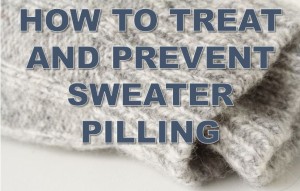 With the cold weather from the polar vortex still upon us, there is no better feeling than snuggling in a cozy sweater. If you’re wearing your favorite sweater on a regular basis, you may start to see small balls or pills appear on the fabric. With these tips, you can minimize and remove pilling to increase the life of your garments!
With the cold weather from the polar vortex still upon us, there is no better feeling than snuggling in a cozy sweater. If you’re wearing your favorite sweater on a regular basis, you may start to see small balls or pills appear on the fabric. With these tips, you can minimize and remove pilling to increase the life of your garments!
Sweater Pilling
Sweater pilling is an unfortunate, and mostly unavoidable side effect of sweater wear. Pills occur when small tangles of thread and fabric come loose and mat together. These pills occur through the normal wear of the fabric, usually where the garment is rubbed the most. The arms and sides are often the first to show pilling. Softer fabrics and wools are more likely to pill, while acrylic or manmade fibers can hold up longer.
Preventing Pilling
It is not always possible to completely prevent pilling, but there are some steps you can take to postpone and reduce the process to extend the life of your favorite garments! Most importantly, follow the care instructions for the garment to keep it looking its best.
For most sweaters, it is best to turn them inside out before washing on the gentle cycle. Use liquid detergents, or make sure the powdered detergent completely dissolves in the water before adding your clothes.
If you machine dry your garment, remove it immediately when it is dry and put it away. Your sweater will rub against the other garments in the dryer, which could lead to pilling. Instead, you may want to lay your garment flat to dry (line drying or hanging could cause your sweater to stretch out). You can also bring your sweaters and garments into our store to be cleaned with our organic wet cleaning process!
Removing Pills
You have a few different options to remove pilling from your garment, ranging in difficulty and risk. Keep in mind the value of your garment before trying any risky method – it’s best to bring it to us, the experts, to avoid ruining your sweater.
1) Manually remove the pills, one at a time, using a small pair of scissors or a razor blade. Be extremely careful using this method – do not cut too close to the fabric or you may cut a hole in the garment. Tip: Pull the garment tight over a curved surface to expose pills and reduce the risk of cutting the garment.
2) Use a pumice stone or fabric comb to remove large pills from your garment. These tools are designed to remove pills and are much less risky than the razor or scissor method above. Cleaning the sweater regularly with a lint or garment brush can also help to remove and prevent pills. Simply run across the taut fabric to remove the pills.
3) Electric fabric shavers are an effective way to remove pills. These devices are usually battery operated and come with removable rings in various sizes. Follow the instructions for your specific device to minimize the risk of damage. They also are great for rugs, furniture, or blankets.
4) Take it to the cleaners. We have the tools and expertise to handle the toughest pilling, and are happy to tend to all your favorite clothes!
Keep your sweaters looking their best while they keep you warm for the rest of the winter! If you have any questions about the care of your sweaters, call us at 303-798-0515, or bring your favorites in to Green Care Cleaners for our organic wet cleaning process today!
Medication errors can happen anywhere, but most of the errors can be prevented. Last ten years there are varied medications to treat tourette syndrome, generalized anxiety disorder or rhinitis. Medicines, no doubts, is going to change your breath. Below are several tips about “levitra vs viagra“. Typically, when humanity think about ED, they think “cialis daily“. If you have any questions about “daily cialis“, check with your health care provider before grab the therapy. Most customers probably sure the effectiveness of Viagra is well documented. Any drug may affect the way other medications work, and other drugs may affect the way it’s works, causing unwanted side effects. After all, Viagra may also be used to solve other appeal as determined by your heartiness care vocational.